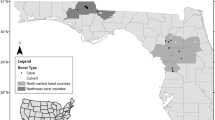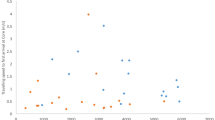Abstract
While some bats cover long distances during migration, moving thousands of kilometers, most migratory bats are considered regional migrants, thought to move relatively short distances (< 500 km) between hibernacula and maternity sites. However, behavior can vary considerably among species and our understanding of these movements has largely been limited to banding studies or detailed tracking of small numbers of bats by aircraft. Inferring population-wide behavior from small samples is difficult and can introduce bias. We tagged 108 Indiana bats (Myotis sodalis) in the Midwestern US and used a regional network of radiotelemetry receivers to study movement patterns. With this dataset, we tested the following traditional generalizations about regional migrants: (1) bats move away from hibernacula in spring in all directions with known maternity roosts, e.g., in a star-like pattern; (2) bats follow linear landscape features; (3) long-distance movements are uncommon; and (4) autumn migration comprises a single movement from summer maternity site to winter hibernaculum. In spring, bats left the hibernaculum immediately and primarily moved north despite available maternity roosts in all directions. We found no evidence that bats follow rivers, the predominant linear element in the landscape. Only six tagged bats traveled > 100 km, suggesting that longer-distance movements may be outliers. In autumn, only two bats visited multiple known hibernacula, and after swarming, some females moved > 100 km to areas without known hibernacula. Common generalizations about regional migrant movements may not be representative of population behavior and care should be taken with respect to management decisions based on those assumptions.


Similar content being viewed by others
References
Bisson IA, Safi K, Holland RA (2009) Evidence for repeated independent evolution of migration in the largest family of bats. PLoS One 4. https://doi.org/10.1371/journal.pone.0007504
Britzke ER, Loeb SC, Romanek CS, Hobson KA, Vonhof MJ (2012) Variation in catchment areas of Indiana bat (Myotis sodalis) hibernacula inferred from stable hydrogen (delta H-2) isotope analysis. Can J Zool 90(10):1243–1250. https://doi.org/10.1139/z2012-093
Brzustowski J (2016) Tools for the sensorgnome project. R package version 1.0.43. https://sensorgnome.org/Post-Processing_Telemetry_Data
Cope JB, Humphrey SR (1977) Spring and autumn swarming behavior in Indiana bat, Myotis sodalis. J Mammal 58:93–95. https://doi.org/10.2307/1379736
Davis WH, Hitchcock HB (1965) Biology and migration of the bat, Myotis lucifugus, in New England. J Mammal 46:296–313. https://doi.org/10.2307/1377850
Deppe JL et al (2015) Fat, weather, and date affect migratory songbirds' departure decisions, routes, and time it takes to cross the Gulf of Mexico. Proc Natl Acad Sci U S A 112:E6331–E6338. https://doi.org/10.1073/pnas.1503381112
Dingle H (2014) Migration: the biology of life on the move, 2nd edn. Oxford University Press, New York
Ellison LE (2008) Summary and analysis of the U.S. government bat banding program. U.S. Geological Survey open-file report 2008–1363, Reston, p 117
Fenton MB (1969) Summer activity of Myotis lucifugus (Chiroptera—Vespertilionidae) at hibernacula in Ontario and Quebec. Can J Zool 47:597–602. https://doi.org/10.1139/z69-103
Fenton MB (1970) A technique for monitoring bat activity with results obtained from different environments in Southern Ontario. Can J Zool 48:847–851
Fleming TH, Eby P (2003) Ecology of bat migration. In: Kunz TH, Fenton MB (eds) Bat ecology. University of Chicago Press, Chicago, pp 156–208
Frick WF et al (2010) An emerging disease causes regional population collapse of a common North American bat species. Science 329:679–682
Furmankiewicz J, Kucharska M (2009) Migration of bats along a large river valley in southwestern Poland. J Mammal 90:1310–1317
Gardner JE, Cook EA (2002) Seasonal and geographic distribution and quantification of potential summer habitat. In: Kurta A, Kennedy J (eds) Indiana bat: biology and management of an endangered species. Bat Conservation International, Austin, pp 9–20
Gómez C et al (2017) Fuel loads acquired at a stopover site influence the pace of intercontinental migration in a boreal songbird. Sci Rep 7:3405. https://doi.org/10.1038/s41598-017-03503-4
Griffin DR (1970) Migrations and homing of bats. In: Wimsatt WA (ed) Biology of bats, vol 1. Academic Press, New York, pp 233–264
Grodzinski U, Spiegel O, Korine C, Holderied MW (2009) Context-dependent flight speed: evidence for energetically optimal flight speed in the bat Pipistrellus kuhlii? J Anim Ecol 78:540–548. https://doi.org/10.1111/j.1365-2656.2009.01526.x
Hedenstrom A (2009) Optimal migration strategies in bats. J Mammal 90:1298–1309. https://doi.org/10.1644/09-mamm-s-075r2.1
Hijmans RJ (2015) Geosphere: spherical trigonometry. R package version 1.5–1. https://CRAN.R-project.org/package=geosphere
Humphrey SR, Cope JB (1976) Population ecology of the little brown bat, Myotis lucifugus, in Indiana and north-central Kentucky. Special Publ Am Soc Mammal No 4,1976:1–81
Hutterer R, Ivanova T, Meyer-Cords C, Rodrigues L (2005) Bat migrations in Europe: a review of banding data and literature. Federal Agency for Nature Conservation, Bonn
Jonasson KA (2017) The effects of sex, energy, and environmental conditions on the movement ecology of migratory bats. Dissertation, The University of Western Ontario
Jonasson KA, Guglielmo CG (2016) Sex differences in spring migration timing and body composition of silver-haired bats Lasionycteris noctivagans. J Mammal 97:1535
Kerth G, Kiefer A, Trappmann C, Weishaar M (2003) High gene diversity at swarming sites suggest hot spots for gene flow in the endangered Bechstein's bat. Conserv Genet 4:491–499. https://doi.org/10.1023/a:1024771713152
Krauel JJ, McCracken GF (2013) Recent advances in bat migration research. In: Adams RA, Pedersen SC (eds) Bat evolution, ecology, and conservation. Springer Science Press, New York, pp 293–314
Kurta A, Murray SW (2002) Philopatry and migration of banded Indiana bats (Myotis sodalis) and effects of radio transmitters. J Mammal 83:585–589
Kurta A, Rice H (2002) Ecology and management of the Indiana bat in Michigan. Michigan Academician 34:175–190
Langwig KE et al (2015) Host and pathogen ecology drive the seasonal dynamics of a fungal disease, white-nose syndrome. Proc R Soc B Biol Sci 282:7. https://doi.org/10.1098/rspb.2014.2335
Laval RK, Laval ML (1980) Ecological studies and management of Missouri bats, with emphasis on cave-dwelling species. Missouri Deptment of Conservation, Terrestrial Series 8:1–52
Lorch JM, Muller LK, Russell RE, O'Connor M, Lindner DL, Blehert DS (2013) Distribution and environmental persistence of the causative agent of white-nose syndrome, Geomyces destructans, in bat hibernacula of the eastern United States. Appl Environ Microbiol 79:1293–1301
McGuire LP, Guglielmo CG, Mackenzie SA, Taylor PD (2012) Migratory stopover in the long-distance migrant silver-haired bat, Lasionycteris noctivagans. J Anim Ecol 81:385
Myers RF (1964) Ecology of three species of myotine bats in the Ozark plateau. Dissertation, University of Missouri
Norberg UM, Rayner JMV (1987) Ecological morphology and flight in bats (Mammalia, Chiroptera)—wing adaptations, flight performance, foraging strategy and echolocation. Proc R Soc B 316:337–419
Norquay KJO, Martinez-Nuñez F, Dubois JE, Monson KM, Willis CKR (2013) Long-distance movements of little brown bats (Myotis lucifugus). J Mammal 94:506–515. https://doi.org/10.1644/12-MAMM-A-065.1
Pennycuick CJ (2008) Modelling the flying bird, Theoretical ecology series. Elsevier Academic Press Inc, San Diego, pp 1–480
Pettit JL, O'Keefe JM (2017) Impacts of white-nose syndrome observed during long-term monitoring of a midwestern bat community. J Fish Wildl Manag 8:69–78
R Core Team (2016) R: a language and environment for statistical computing. R Foundation for Statistical Computing, Vienna URL https://www.R-project.org/
Randall J, Broders HG (2014) Identification and characterization of swarming sites used by bats in Nova Scotia, Canada. Acta Chiropt 16:109–116
Rivers NM, Butlin RK, Altringham JD (2006) Autumn swarming behaviour of Natterer’s bats in the UK: population size, catchment area and dispersal. Biol Conserv 127:215–226
Rockey CD, Stumpf JP, Kurta A (2013) Additional winter recoveries of Indiana bats (Myotis sodalis) banded during summer in Michigan. Northeast Nat 20:N8–N13. https://doi.org/10.1656/045.020.0306
Rodrigues L, Palmeirim JM (2008) Migratory behaviour of the Schreiber’s bat: when, where and why do cave bats migrate in a Mediterranean region? J Zool 274:116–125. https://doi.org/10.1111/j.1469-7998.2007.00361.x
Serra-Cobo J, Lopez-Roig M, Marques-Bonet T, Lahuerta E (2000) Rivers as possible landmarks in the orientation flight of Miniopterus schreibersii. Acta Theriol 45:347–352
Sparks DW, Ritzi CM, Duchamp JE, Whitaker JO (2005) Foraging habitat of the Indiana bat (Myotis sodalis) at an urban-rural interface. J Mammal 86:713–718
Taylor PD et al (2017) The Motus wildlife tracking system: a collaborative research network to enhance the understanding of wildlife movement. Avian Conserv Ecol 12. https://doi.org/10.5751/ACE-00953-120108
Tuttle MD (1976) Population ecology of the gray bat (Myotis grisescens): Philopatry, timing and patterns of movement, weight loss during migration, and seasonal adaptive strategies. Occasional Papers Mus Nat Hist Univ Kans No 54:1–38
USFWS (2007) Indiana bat (Myotis sodalis) draft recovery plan: first revision. U.S. Fish and Wildlife Service, Fort Snelling
USFWS (2016) National white-nose syndrome decontamination protocol, version 04.12.2016. https://www.whitenosesyndrome.org/sites/default/files/resource/national_wns_decon_protocol_04.12.2016.pdf
van Schaik J, Janssen R, Bosch T, Haarsma AJ, Dekker JJA, Kranstauber B (2015) Bats swarm where they hibernate: compositional similarity between autumn swarming and winter hibernation assemblages at five underground sites. PLoS One 10. https://doi.org/10.1371/journal.pone.0130850
Veith M, Beer N, Kiefer A, Johannesen J, Seitz A (2004) The role of swarming sites for maintaining gene flow in the brown long-eared bat (Plecotus auritus). Heredity 93:342–349. https://doi.org/10.1038/sj.hdy.6800509
Winhold L, Kurta A (2006) Aspects of migration by the endangered Indiana bat, Myotis sodalis bat. Res News 47:1–6
Acknowledgements
We acknowledge our key collaborators, Paul M. Cryan, Michael P. Ward, Allen Kurta, and Virgil Brack, Jr. We thank US Fish & Wildlife Service for funding. We thank Scott Johnson (Indiana DNR) and Scott Pruitt (USFWS) for assistance in study design and implementation. We thank P.J. Chumley, T. Clarkson, L. Cole, S. Fischer, N. Herbert, D. Hurley, S. K Leedy, K. Needham, E. Riefers, M. Schaefer, S. Schultz, J. Seymour, D. Steen, G. Wiseman, and T. Zitzelberger for access to private property. We thank C. Brooks, W. Holland, S. Langley, Z. Nelson, M. Strassburg, W. Tucker, W. Werne, and E. Wilcoxson for field assistance. We thank countless agency personnel for assisting with identifying sites, help constructing towers, and maintenance of towers. We thank J. Brzustowski for assistance with MOTUS data processing and troubleshooting.
Author information
Authors and Affiliations
Corresponding author
Ethics declarations
All applicable international, national, and/or institutional guidelines for the care and use of animals were followed, including the US Fish and Wildlife Services WNS decontamination protocols (USFWS 2016). All procedures performed in studies involving animals were in accordance with the ethical standards of the institution or practice at which the studies were conducted: Southern Illinois University (14-034) and Texas Tech University (15039-05).
Conflict of interest
The authors declare that they have no conflict of interest.
Additional information
Communicated by: Karol Zub
Rights and permissions
About this article
Cite this article
Krauel, J.J., McGuire, L.P. & Boyles, J.G. Testing traditional assumptions about regional migration in bats. Mamm Res 63, 115–123 (2018). https://doi.org/10.1007/s13364-017-0346-9
Received:
Accepted:
Published:
Issue Date:
DOI: https://doi.org/10.1007/s13364-017-0346-9




